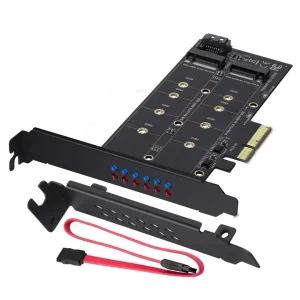MZHOU NVME M.2 SSD M-Key to PCI-e 3.0 x1 Host Controller Expansion Card
- 【 VERSATILE APPLICATION&M KEY PCIE SSD CARD】Adds an M.2 PCIe SSD (M-Key) to your PCIe-equipped desktop computer (Windows 11,10, 8, 7, XP, etc.) to significantly increase speed and performance. Supports PCIE 3.0 motherboards and is backward compatible with PCIE 1.0 and PCIe 2.0. Also supports PCIE x1 bus slot.
- 【HIGH PERFORMANCE】 The NVMe PCIe card allows you add M.2 PCI-e NVME SSD to your motherboard without M.2 slot, perfect solution for PC upgraded.
- 【APPLICABLE SSD HARD DRIVE】The M.2 PCIE adapter ONLY supports PCI-E NVME based M Key (NVMe & AHCI), NOT supports any SATA based SSD. Fit for PCIE x1/x4/ x8/ x16 slot.
- 【 EASY SETUP】 No driver installation required (if an exclamation mark appears after installing the adapter, ask the SSD manufacturer to offer the NVME driver for SSD for PCIE). Includes both flat and full profile brackets for installing flexible system chassis, ideal for 2U enclosures.
- 【INTUITIVE DESIGN】Suitable for 2230, 2242, 2260 and 2280 M.2 SSDs (NVME or AHCI) over several mounting holes ! NOTE: Systems released before 2015 may not support NVME SSDs. Please ask your system provider for compatible SSD.
Additional information
Additional information
| Weight | 0.02 kg |
|---|---|
| Dimensions | 13 × 13 × 1 cm |

MZHOU NVME M.2 SSD M-Key to PCI-e 3.0 x1 Host Controller Expansion Card
Description
MZHOU M.2 NGFF SSD PCIE Card Desktop Adapter with a PCIe adds M.2 PCIe SSD (M button) to improve performance and speed. The M.2 SSD PCIe adapter suitable for different dimensions of high-performance M.2 PCIe (M-key) SSD, have a variety of mounting options.
Suitable conditions:
1. 1x PCI-E over the socket (note 1x PCI-E interface speed of 3.0 or more is halved, but still faster than SATA)
2. The motherboard that does not support the NVME protocol cannot be used as a system hard drive, but only as a storage hard drive.
INTEL motherboard chipset:
B250 B150 H170 Z170, provided that the motherboard with M.2 interface is generally supported by NVME. Z97 part of the support, especially on the official website
B85 Z87 must update the BIOS support, part of the conscience of the manufacturer’s support NVME have provided the BIOS, such as Asus and ASRock etc., when the official is not, on their own difficult to change BIOS, especially the online Search tutorial requires some skill, there is damage to the motherboard risk. (Most B85 do not offer an M.2 interface. You can use our M.2 to PCI-E adapter card.)
AMD motherboard chipset:
B350 X370 X399 A320 support, the former is not support, which only needs to be used to support NVME RYZEN the CPU board.
Support PCI-E and NVME standard M2.SSD, does not support the older SATA M2.SSD important things to say once, does not support SATA M2 SSD, on the UEFI BIOS to the latest version before cleaning old-fashioned BIOS only as storage disk, not system disk.
NOTE about the speed
(For NVME SSDS that support PCI-E 3.0)
A: running PCI-E 1.0 GEN1:200M to 300M/S
B: running PCI-E 2.0 GEN2: 400M to 500M/S
C: running PCI-E 3.0 GEN2: 700M to 800M/S





















Sassan Karai
Works fine for me with PCIe Gen4
Mikey In Buffalo
Works fine for me with PCIe Gen4
I used this SINGLE-LANE card alone with a Z97-based MSI motherboard, and was able to upgrade the BIOS to enable me to boot from an older mSATA-based motherboard that did not support NVME at all into a motherboard that would boot from an NVME-drive mounted through a PCI-slot. I am using my multi-lane slots for video cards, and blackmagic decklink video capture cards that need the high bandwidth. So slurping up extra bandwidth with these cards is “dope” IMO.
I recommend this one for places where you only have a single-lane, and I recommend the STARTECH 4x solution if you want to get into the faster-speeds and if you have the 4x-lane available. It’s wise to have an extra at these prices, and I have an extra single-lane card for when I just need to get one to work (for example, a friend brings over an NVME and wants me to read it and I want it to be more reliable and faster than over USB connection.
If you look at this card, it’s about the cheapest card ever produced, it has three diodes, seven capacitors, five resistors. Only fifteen total pieces besides the connectors and the PC-board. This is not bad, just understand that is literally just wiring your NVME directly up to your PCIe-bus, and it’s the fastest way to access your NVME. Only the single-lane is holding you back, and for smaller writes, like compiling code, it’s going to be fine. For moving around large media files, you may still want to get a 4x-lane card instead of this one if you have the lanes available. But adding multiple of these where you have a MB like I have, you can put plenty of these single-lane cards in and use a software raid solution to get better bandwidth if all your remaining PCI bandwidth is already allocated! This can be a great solution with multiple cards in a video-editing rig, for example, that just needs cheap and plentiful editing space for doing projects.